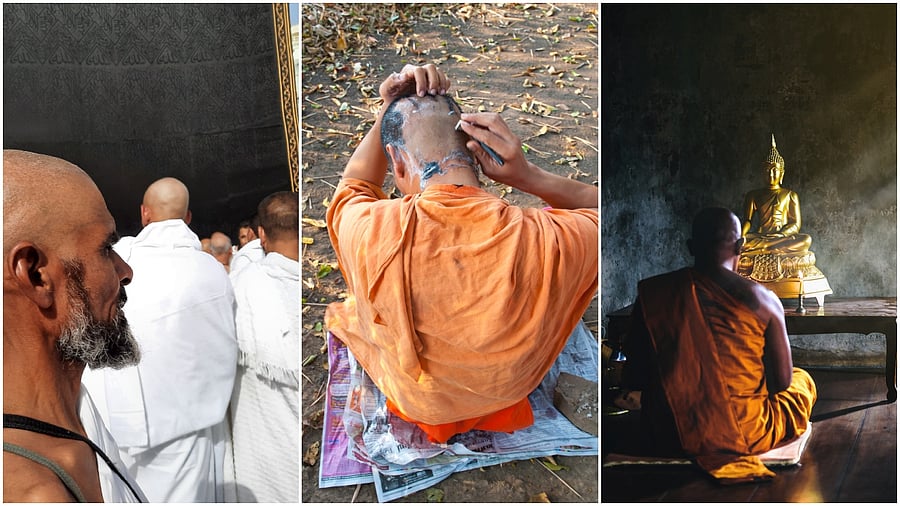
Shaved heads: Hajj pilgrims (L); A Hindu monk (C); a Buddhish monk (R). Shaving the head is also a common practice during funeral ceremonies to express bereavement. However, a tuft of hair is often left behind to indicate that the person has not fully renounced the world.
Credit: iStock Photos
According to legend, when Shankaracharya went to meet Brahmin scholar Mandan Mishra, around 700 AD, Mishra refused to look at him because his head was shaved. This is why the Shankaracharyas cover their heads with cloth even today, as shaven heads are still seen as symbols of bad luck and inauspiciousness. Householders once shunned all hermits.
Traditionally, ancient Vedic sages had long hair that they tied in a knot. Rig Veda refers to the long-haired Keshin looking at the sky. Linked to Rudra, these may have been the Vedic counterparts of the Akhara Nagas, though they became institutionalised only after 1500 AD. On the Sanchi stupas, it is clear that the rich men of cities, who lived 2,000 years ago, also had long hair. They ornamented these hair knots with jewels.
When Buddha became a monk, he also shaved his head and gave away his hair. It was collected by Sakra, king of the gods. Later, he gave a tuft of his hair to merchants, Tapussa and Bhallika of Ukalapada, who began the practice of placing Buddha’s relics (hair, teeth, bones) in a stupa. The Shwedagon pagoda in Myanmar is said to contain the Buddha’s hair.
Buddha and his monks shaved their heads to declare their status as hermits and to avoid the attention of women. However, when artworks of Buddha began to be created, after 100 AD, he was depicted with a top knot, as people disliked images of men with shaved heads.
Later, as Buddhism spread to China and Japan, where shaven heads were common among Taoist monks, the image of the shaven-headed Buddhist monk became very popular, resulting in figures like the laughing Buddha with a shaved head. Buddha’s topknot was replaced by a flame in Thailand.
In Jainism, monks pluck their hair to show they have renounced all worldly attachments. However, in art, Jain Tirthankaras are often shown with curly hair, and Rishabh Nath is depicted with long hair falling over his shoulders.
Hair has long been used to communicate various meanings. The shaven head signifies renunciation, while a full head of well-oiled hair indicates virility and masculine beauty. Balarama is described as having long, silky hair. Krishna is described as having thick curly hair. In the Mahabharata, there is a story where Krishna teaches Rukmi a lesson by shaving half his head and half his moustache.
Shiva, as the wild ascetic, has matted dreadlocks bound with birch juice and tied in a knot, so thick that it can even break the fall of the river Ganga as she descends from the skies to earth. This matted lock is home to the crescent moon too.
The Brahmins shave part of their hair to symbolise their role in the spiritual world, yet retain a top knot and a tuft of hair to show they are still connected to the material world. This reflects their role as neither complete hermits nor entirely householders. In folklore, it is said that Chanakya undid his topknot and vowed not to tie it until he avenged his humiliation at the hands of King Nanda. In folk theatre, Narada, the mischievous sage, is shown with flowers on his topknot, the flowers giving out the fragrance of Vaijayanti, the garland of Krishna.
Shaving the head is also a common practice during funeral ceremonies to express bereavement. However, a tuft of hair is often left behind to indicate that the person has not fully renounced the world. Shaving the full head indicates renunciation, sanyasa. Hair was seen as a symbol of vanity even in the Mediterranean region, and so Christian monks shaved their heads.
In ancient times, warriors typically wore their hair long. Jewish Bible (Old Testament of the Christians) tells the story of how Samson lost his superhuman strength when Delilah shaved off his head. Then there is the story of Prince Absalom, who was proud of his thick hair. He rebelled against his father. While escaping from soldiers, his hair got caught in the branches of a tree. He was pulled out of a chariot, and was caught and killed.
In Greek myth, Achilles cut his long hair to mourn the loss of his beloved friend Patrolocus. The Roman army popularised the crew cut to prevent enemies from grabbing soldiers’ hair and slitting their throats. In the 1700s, when Guru Gobind Singh established the Khalsa, Sikh warriors stopped cutting their hair and tied it in a turban. This made all soldiers distinct as they marched against their Mughal oppressors.
In Japan, as Buddhism spread, the practice of shaving the head gained popularity. In earlier days, men had long hair and beards, but in the Edo period of the 1600s, samurai warriors were required to have clean-shaven faces. This helped reduce sweating when wearing helmets. The back of the head retained hair tied into a top knot to secure the helmet, which made it more practical for the samurai. Over time, this became a fashion statement and a symbol of civilised behaviour.
(Devdutt Pattanaik is the author of more than 50 books on mythology. X: @devduttmyth.)
Disclaimer: The views expressed above are the author's own. They do not necessarily reflect the views of DH.